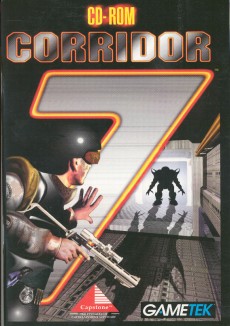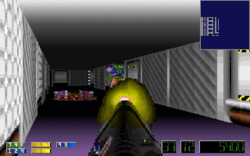Software:Corridor 7: Alien Invasion
| Corridor 7: Alien Invasion | |
|---|---|
 CD cover art | |
| Developer(s) | Capstone Software |
| Publisher(s) | IntraCorp GameTek |
| Engine | Modified Wolfenstein 3D engine |
| Platform(s) | MS-DOS |
| Release | March 1994 |
| Genre(s) | First-person shooter |
| Mode(s) | Single-player, Multiplayer |
Corridor 7: Alien Invasion is a first-person shooter video game developed by Capstone Software and published by IntraCorp and GameTek. The game received poor reception, largely due to its use of the outdated Wolfenstein 3D engine. A sequel, Corridor 8: Galactic Wars, was announced but later canceled.
Plot
The staff of a top-secret research laboratory, Corridor 7, inadvertently opens an interdimensional portal known as the Vortex while experimenting on an alien artifact recovered from Mars. Shortly after, hostile aliens emerge from the Vortex and kill all of the staff. The player, as a lone Special Forces soldier, enters the base to fight the aliens and destroy the source of their power.
Game play

Corridor 7 consists of 30 floors (with 40 floors in the CD version) and 6 bonus floors. The player is tasked with killing a certain number of enemies before the exit to the next floor is accessible. There are four difficulty settings, which modify the number of enemies that need to be eliminated and how much damage the player will take from enemy attacks and traps. In the CD version, there is a fifth setting, which randomly scatters items and enemies throughout the game.
The player can activate the proximity map in one corner of the screen, showing a small section of the current level with active aliens marked in yellow. The map can be expanded by finding the floor plan. The player is equipped with a visor capable of both infrared and night vision. Infrared is employed to detect invisible traps, while night vision enhances the player's vision in dark areas of the game. Ammunition and health are not scattered around the levels as objects to pick up, but rather as dispenser bays encased in the level walls. Health is also available in rooms called "health chambers", where the player can obtain up to 100 hit points. There are two ammo types for human firearms and alien firearms.
Locked areas require a color-coded (blue or red) pass card to be opened, which are granted by interacting with computer terminals.
Multiplayer
The success of the multiplayer modes in Doom is believed to be the reason behind the addition of LAN and modem game play modes in the CD release of Corridor 7. The only multiplayer mode featured is deathmatch, with 8 multiplayer maps included. Players can play as either the Special Forces soldiers from the single-player mode or as one of the aliens; playing as an alien results in possessing the distinctive abilities of the creature chosen (e.g. speed or endurance).
Reception
Corridor 7 received mixed reviews at launch. Chris Anderson of PC Zone stated that the game offered "nothing new and what is there isn't very exciting", and largely criticized its use of the Wolfenstein 3D engine.[1]
| Reception | ||||||
|---|---|---|---|---|---|---|
| ||||||
Legacy
Corridor 8: Galactic Wars was the planned sequel to Corridor 7. The game was in development and used the Build engine, though it was never finished because the developer, Capstone Software, went bankrupt along with their parent company, IntraCorp, in 1996. The game only made it to prototype stage. In 2005, Les Bird sent the Corridor 8 prototype source code to a Corridor 7 fan, who put it onto his website as a free download.
References
- Steven M. Schafer, Corridor 7 Official guide - Brady publishing 1994
- ↑ Anderson, Chris (July 1994). PC Zone 16 (July 1994). Future plc.. pp. 62–63. http://archive.org/details/PC_Zone_16_July_1994.
- ↑ Anderson, Chris (July 1994). "PC Zone Review - Corridor 7". PC Zone (Future plc) (16): 63. https://archive.org/details/PC_Zone_16_July_1994/page/n61.
External links
- Les Bird's Capstone Game Archive Includes Corridor 8 prototype source code and Corridor 7 design documents
- MobyGames is a commercial database website that catalogs information on video games and the people and companies behind them via crowdsourcing. This includes over 300,000 games for hundreds of platforms.[1] Founded in 1999, ownership of the site has changed hands several times. It has been owned by Atari SA since 2022.
Features
Edits and submissions to the site (including screenshots, box art, developer information, game summaries, and more) go through a verification process of fact-checking by volunteer "approvers".[2] This lengthy approval process after submission can range from minutes to days or months.[3] The most commonly used sources are the video game's website, packaging, and credit screens. There is a published standard for game information and copy-editing.[4] A ranking system allows users to earn points for contributing accurate information.[5]
Registered users can rate and review games. Users can create private or public "have" and "want" lists, which can generate a list of games available for trade with other registered users. The site contains an integrated forum. Each listed game can have its own sub-forum.
History

MobyGames was founded on March 1, 1999, by Jim Leonard and Brian Hirt, and joined by David Berk 18 months later, the three of which had been friends since high school.[6][7] Leonard had the idea of sharing information about computer games with a larger audience. The database began with information about games for IBM PC compatibles, relying on the founders' personal collections. Eventually, the site was opened up to allow general users to contribute information.[5] In a 2003 interview, Berk emphasized MobyGames' dedication to taking video games more seriously than broader society and to preserving games for their important cultural influence.[5]
In mid-2010, MobyGames was purchased by GameFly for an undisclosed amount.[8] This was announced to the community post factum , and the site's interface was given an unpopular redesign.[7] A few major contributors left, refusing to do volunteer work for a commercial website.{{Citation needed|date=June 2025} On December 18, 2013, MobyGames was acquired by Jeremiah Freyholtz, owner of Blue Flame Labs (a San Francisco-based game and web development company) and VGBoxArt (a site for fan-made video game box art).[9] Blue Flame Labs reverted MobyGames' interface to its pre-overhaul look and feel,[10] and for the next eight years, the site was run by Freyholtz and Independent Games Festival organizer Simon Carless.[7]
On November 24, 2021, Atari SA announced a potential deal with Blue Flame Labs to purchase MobyGames for $1.5 million.[11] The purchase was completed on 8 March 2022, with Freyholtz remaining as general manager.[12][13][14] Over the next year, the financial boost given by Atari led to a rework of the site being built from scratch with a new backend codebase, as well as updates improving the mobile and desktop user interface.[1] This was accomplished by investing in full-time development of the site instead of its previously part-time development.[15]
In 2024, MobyGames began offering a paid "Pro" membership option for the site to generate additional revenue.[16] Previously, the site had generated income exclusively through banner ads and (from March 2014 onward) a small number of patrons via the Patreon website.[17]
See also
- IGDB – game database used by Twitch for its search and discovery functions
References
- ↑ 1.0 1.1 Sheehan, Gavin (2023-02-22). "Atari Relaunches The Fully Rebuilt & Optimized MobyGames Website". https://bleedingcool.com/games/atari-relaunches-the-fully-rebuilt-optimized-mobygames-website/.
- ↑ Litchfield, Ted (2021-11-26). "Zombie company Atari to devour MobyGames". https://www.pcgamer.com/zombie-company-atari-to-devour-mobygames/.
- ↑ "MobyGames FAQ: Emails Answered § When will my submission be approved?". Blue Flame Labs. 30 March 2014. http://www.mobygames.com/info/faq7#g1.
- ↑ "The MobyGames Standards and Practices". Blue Flame Labs. 6 January 2016. http://www.mobygames.com/info/standards.
- ↑ 5.0 5.1 5.2 Miller, Stanley A. (2003-04-22). "People's choice awards honor favorite Web sites". Milwaukee Journal Sentinel.
- ↑ "20 Years of MobyGames" (in en). 2019-02-28. https://trixter.oldskool.org/2019/02/28/20-years-of-mobygames/.
- ↑ 7.0 7.1 7.2 Plunkett, Luke (2022-03-10). "Atari Buys MobyGames For $1.5 Million". https://kotaku.com/mobygames-retro-credits-database-imdb-atari-freyholtz-b-1848638521.
- ↑ "Report: MobyGames Acquired By GameFly Media". Gamasutra. 2011-02-07. https://www.gamedeveloper.com/game-platforms/report-mobygames-acquired-by-gamefly-media.
- ↑ Corriea, Alexa Ray (December 31, 2013). "MobyGames purchased from GameFly, improvements planned". http://www.polygon.com/2013/12/31/5261414/mobygames-purchased-from-gamefly-improvements-planned.
- ↑ Wawro, Alex (31 December 2013). "Game dev database MobyGames getting some TLC under new owner". Gamasutra. https://www.gamedeveloper.com/business/game-dev-database-mobygames-getting-some-tlc-under-new-owner.
- ↑ "Atari invests in Anstream, may buy MobyGames". November 24, 2021. https://www.gamesindustry.biz/articles/2021-11-24-atari-invests-in-anstream-may-buy-mobygames.
- ↑ Rousseau, Jeffrey (2022-03-09). "Atari purchases Moby Games". https://www.gamesindustry.biz/atari-purchases-moby-games.
- ↑ "Atari Completes MobyGames Acquisition, Details Plans for the Site's Continued Support". March 8, 2022. https://www.atari.com/atari-completes-mobygames-acquisition-details-plans-for-the-sites-continued-support/.
- ↑ "Atari has acquired game database MobyGames for $1.5 million" (in en-GB). 2022-03-09. https://www.videogameschronicle.com/news/atari-has-acquired-game-database-mobygames-for-1-5-million/.
- ↑ Stanton, Rich (2022-03-10). "Atari buys videogame database MobyGames for $1.5 million". https://www.pcgamer.com/atari-buys-videogame-database-mobygames-for-dollar15-million/.
- ↑ Harris, John (2024-03-09). "MobyGames Offering “Pro” Membership". https://setsideb.com/mobygames-offering-pro-membership/.
- ↑ "MobyGames on Patreon". http://www.patreon.com/mobygames.
Wikidata has the property:
|
External links
- No URL found. Please specify a URL here or add one to Wikidata.
 |
 |
